Opaque materials in smear slides
by Mark Shapley
Most smear slides will include somewhere between a trace and a few percent grains that do not transmit light and appear opaque in plane-polarized light under a petrographic microscope. These are likely to be of diverse origins, perhaps including charcoal, chitin and other organic debris, sulfide and oxide minerals, and pseudo-opaque slide manufacturing artifacts such as bubbles.
Opaque or near-opaque organic debris are often distinguishable by form and surface texture. Charcoal may show wood grain or the form of plant structure, depending on degree of preservation, and will appear black even along thin edges of a fragment. Unburned but heavily oxidized organic debris may show similar form, but will usually appear brownish along fragment margins. When probed under a dissecting microscope, charcoal often shows a brittle fracture, while oxidized plant debris tends to crumble; material preserved in a smear slide may also exhibit signs of this mechanical contrast between combusted and un-combusted material. Chitin is a common constituent of lacustrine sediment and in some cases may be opaque or nearly so. Chitin preserving the body structures of insects (limbs, eyes, wings, mouth-parts, etc.) is readily recognized. Dark chitin also occurs as irregular fragments that may superficially resemble charcoal, plant debris, or even strongly colored or opaque minerals. Most will show some translucence, and (under a dissecting microscope) will flex readily.
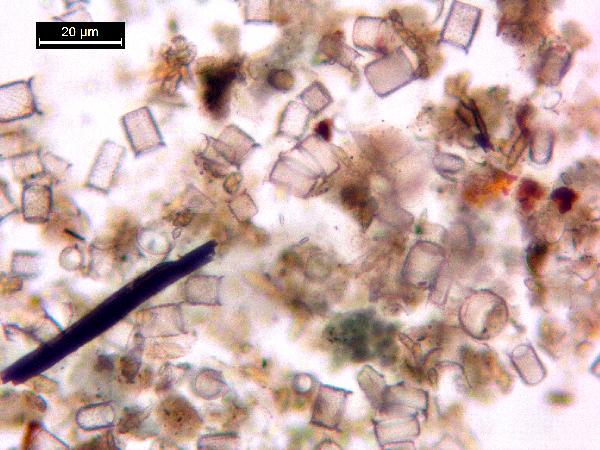 |
| Charcoal |
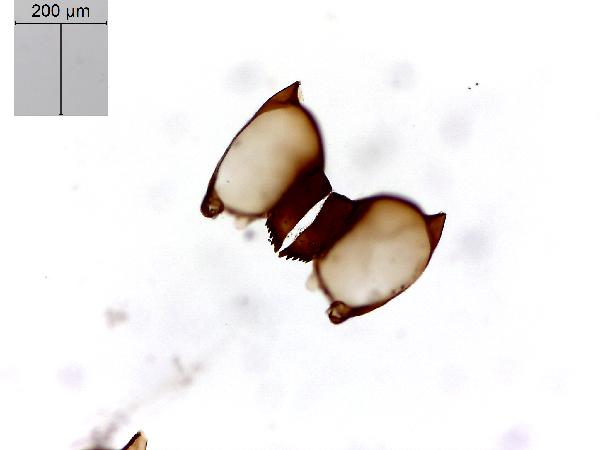 |
| Chitin |
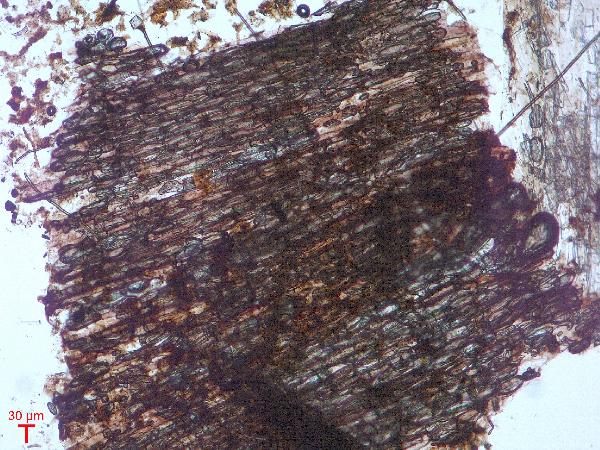 |
| Thick plant material |
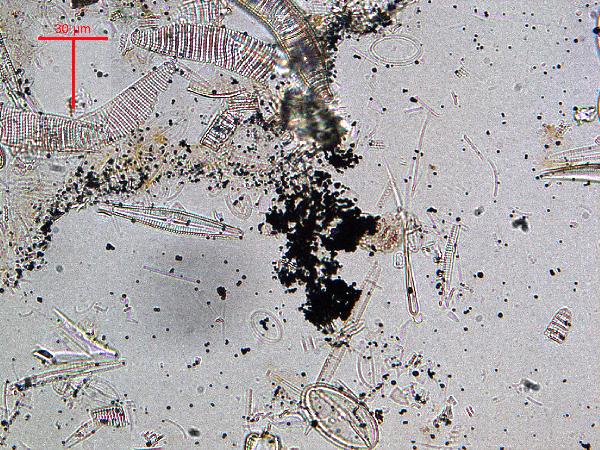 |
| Pyrite |
|
|
|
|
/PRES-MTN12-12B-3L-1_4x_ppl_49cm_sand.jpg) | | Magnetite |
|
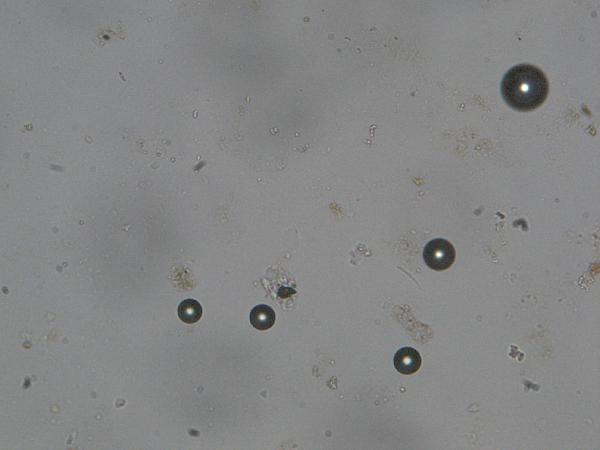 |
| Bubbles |
Truly opaque mineral grains that commonly occur as components of unlithified sediment are most often iron-bearing sulfide or oxide minerals. Distinguishing between them can be challenging, but is valuable for the information to be gained about depositional and diagenetic environments. The presence of sulfide minerals (including pyrite, FeS2, and monosulfides such as greigite, mackinawite, and pyrrhotite) signifies active microbial sulfur cycling, the presence of free sulfide, and a sulfide-based sediment sink for iron and other available cations. In contrast, opaque Fe-oxides, usually magnetite, are typically of detrital origin, often associated with other grains of high specific gravity in clastic lag deposits comprising heavy mineral assemblages or the high-density mineral-rich fraction of some tephras. Other commonly-seen Fe-oxides (e.g. hematite) may appear strongly colored in smear slides but are typically translucent to transparent, rather than opaque. Biomineralized magnetite produced by magnetotactic bacteria is widespread in sedimentary environments, but in a sub-micron size class well below grains discriminated in smear slides.
While Fe-sulfides and magnetite share opacity as a defining characteristic, their optical characteristics under reflected light can help distinguish the two mineral classes. (Oblique reflected light can be cast on the stage of a petrographic microscope using an overhead fiber-optic light source.) Pyrite and greigite typically show a bronze hue in reflected light, while magnetite usually appears gray. Pyrite and greigite very commonly occur in spheroidal aggregates (framboids) of fine sub-micron crystallites, sometimes as infilling or replacement of diatom frustules and other biological structures and very often associated with organic matter, the oxidation of which promotes low redox potential and liberation of sulfide ions necessary for sulfide formation. Pyrite also occurs as monocrystalline, euhedral cubes and octahedra, however, and the latter may be confused with magnetite, which commonly shows this form. Here the assemblage of sediment constituents may provide some of the more useful clues to opaque mineral identification, at least as far as mineral class. An opaque mineral grain with cubic or faceted grain boundaries that is associated with mafic silicate minerals, zircons, or other high-density grains is more likely magnetite or a related oxide, while a similar grain morphometry associated with abundant biogenic material is more likely pyrite. Fine opaque grains associated with biotite or other Fe-bearing silicate minerals may indicate alteration of detrital components and Fe mobility within the sedimentary environment.
Macroscopic (core face) observations also give valuable clues to the mineralogy of opaque phases seen in smear slides. Disseminated Fe-monosulfides (greigite, mackinawite) oxidize within minutes or hours of initial exposure to air, dramatically changing the appearance of freshly split cores if the sulfides are abundant. Such reactive macro-scale behavior from exposed sediments alerts a smear-slide analyst to the presence of Fe-sulfides and/or their oxidized reaction products.
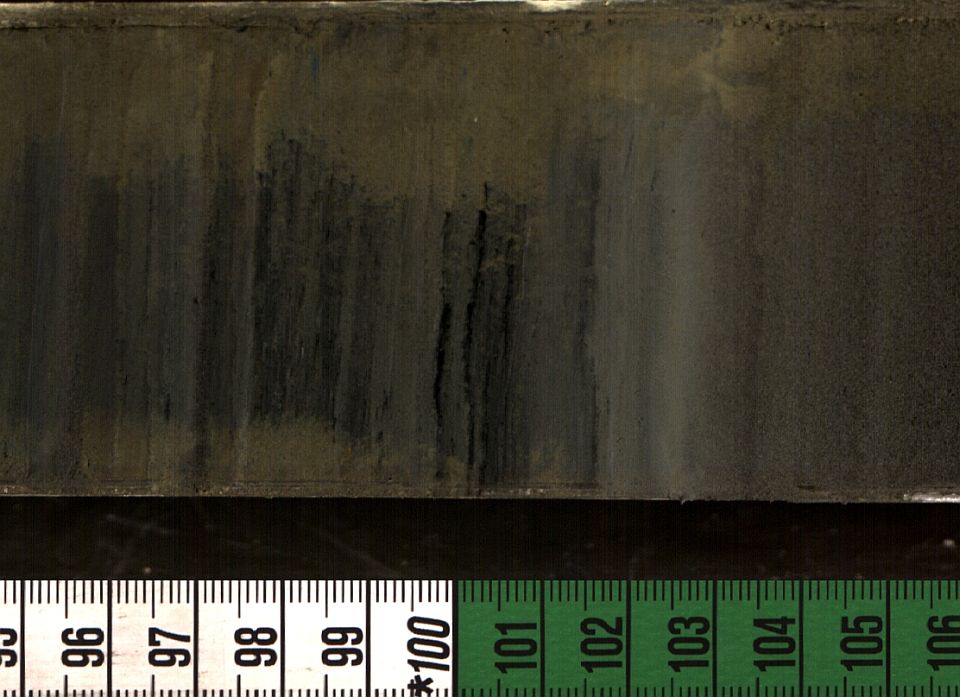 |
| Freshly split core with weakly crystalline sulfides (black) oxidizing at the edges of the core |






/PRES-MTN12-12B-3L-1_4x_ppl_49cm_sand.jpg)
No comments:
Post a Comment